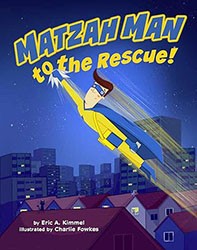Mendel Mendel Shlotz is a Jewish boy residing in the fictional village of Lintvint, Nahsovia — an imaginary Eastern European location — at the turn of the twentieth century. Lintvint is a modest place, best known for its turnips, beans, and a beverage made from goats’ sweat. Yet it is unlike the legendary Chelm, where virtually everyone lacks common sense. In fact, Mendel stands out in Lintvint for his embarrassing incompetence. Everything he tries, from milking a cow to learning Talmud, results in disaster. When brutal Cossacks attack his village, Mendel seems an unlikely candidate to save it. In Terry LaBan’s new graphic novel, sometimes the unexpected happens.
For young readers who may be unfamiliar with Jewish history and folklore, LaBan offers a brief course on both Cossacks and the Evil Eye. Mendel’s weakness is, apparently, the result of a curse placed on him in utero, when his pregnant mother argued with a witchlike character named Starface Matja. With a walking stick as gnarled as her fingers, and one outsized eye glaring from the page, she seems to incarnate the force that terrifies every shtetl Jew. Her malevolent stare has destined Mendel to lifelong ridicule. Despite this, he enjoys the protection of a loving family, even if their Shabbos meals are limited in variety and his performance in the house of study is dismal. One kind companion there, Nuli Sekelmacher, gives him some useful advice, suggesting that Mendel visualize a hand writing out the lesson on a slate.
As LaBan explains in his detailed afterword, Cossacks both provoked and implemented violence against Jews in Eastern Europe. They became almost synonymous with antisemitic terror. Combining enough caricature to be humorous with realistic details for impact, these drunken soldiers “laugh like maniacs, howl like wolves, and finally burst into SONG.” While these characters may be ridiculous, their destructiveness is real. The book’s plot, like so much of Jewish history, involves an elaborate plan to evade ruin. The reappearance of Starface Matja sparks realizations about mistaken identity and misjudged character. Mendel’s instinct is always to help others. Finally, he discovers that failure in this regard is not inevitable.
Bright colors, sharply drawn lines, and an appealing font visually match the narrative. Text boxes alternate in size, and include full page illustrations that grant space to fundamental parts of the story. Cossacks in different colored uniforms share a page with white goats, interspersed throughout the crowd of waking soldiers (“What’s this? GOATS! The whole square is FULL of them!”). Another page features a group of Jews looking down from their elevated hiding place towards a village in flames. Mendel’s changing facial expressions reflect his fear, but also his growing sense of determination. After all, a curse may be only a pretext, and even mistakes can bring about change.
Emily Schneider writes about literature, feminism, and culture for Tablet, The Forward, The Horn Book, and other publications, and writes about children’s books on her blog. She has a Ph.D. in Romance Languages and Literatures.





